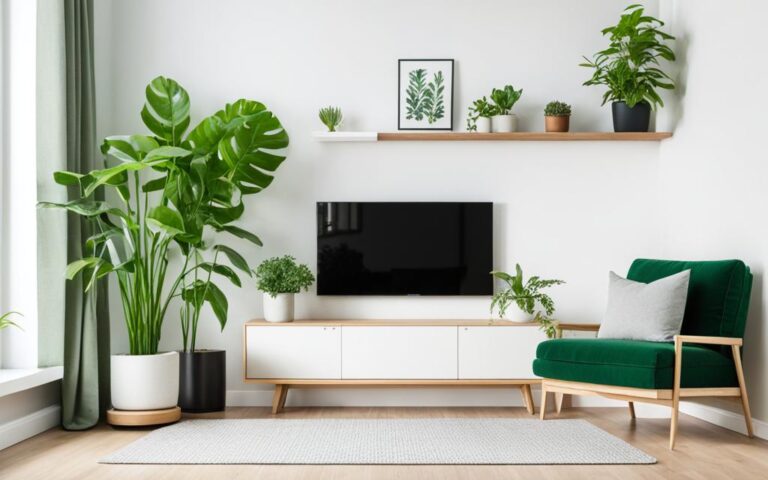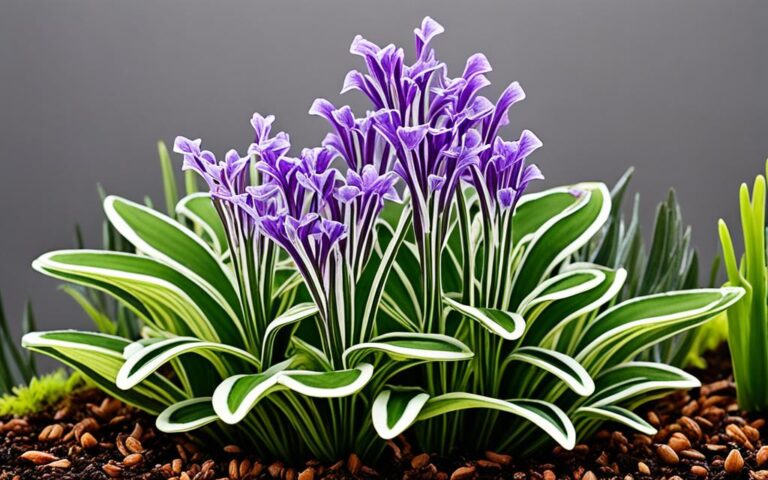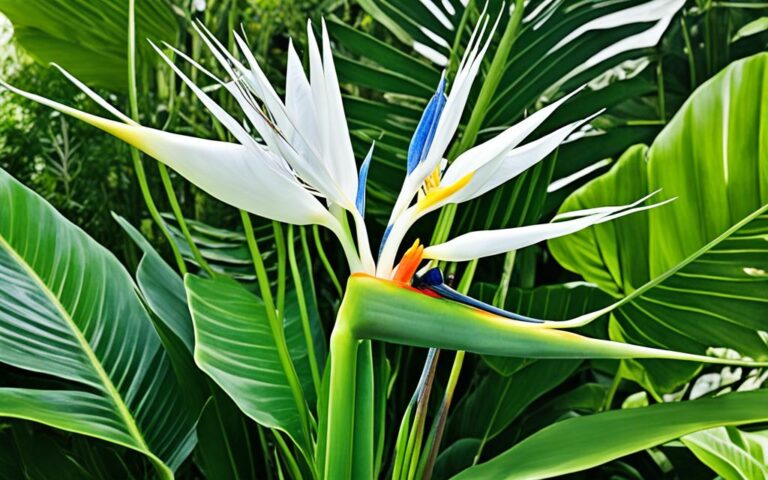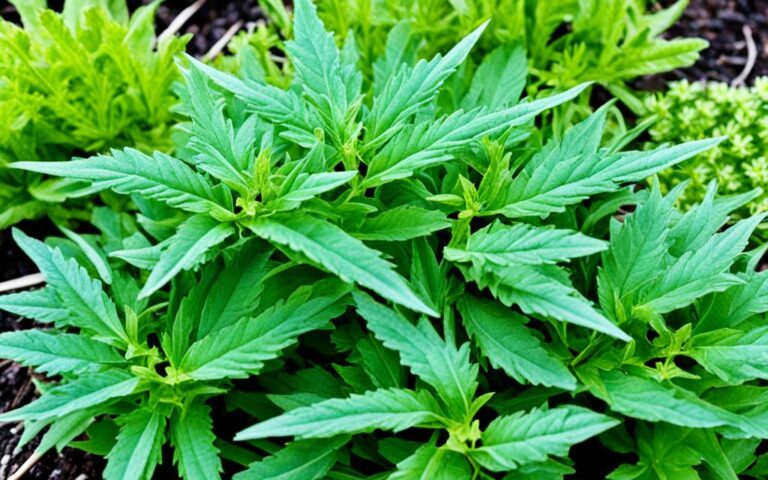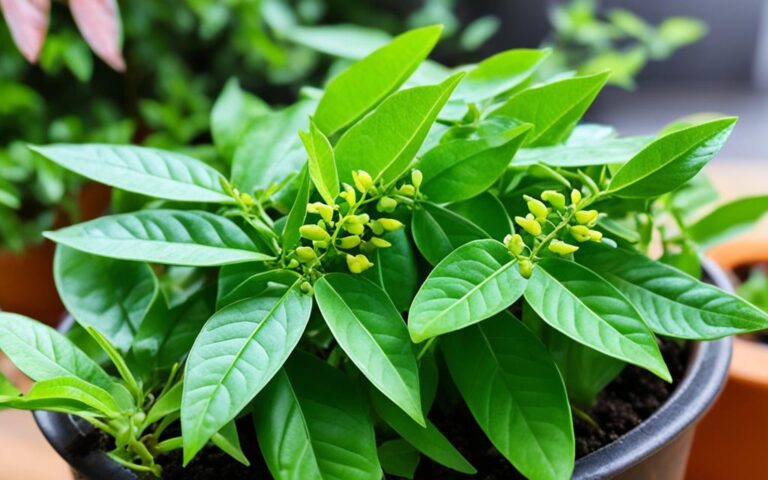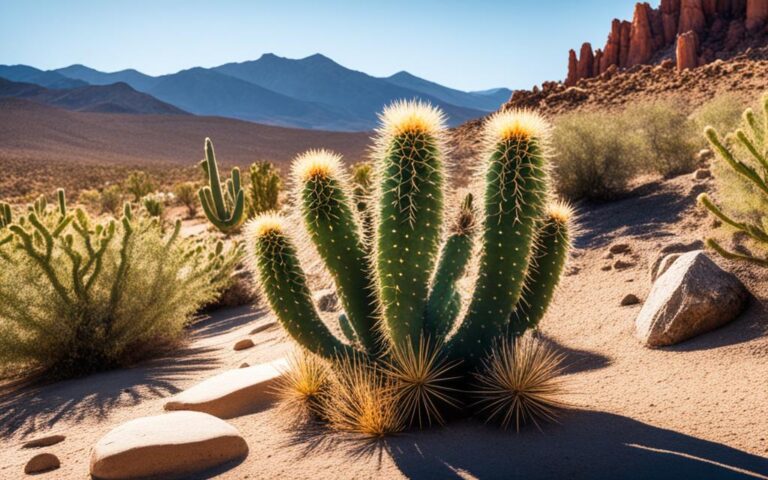Bottle Brush Plant: Colorful Aussie Shrub for Gardens
Did you know the bottle brush plant is from Australia and grows well in many parts of the U.S.? This shrub or small tree is loved by birds and insects for its nectar. It’s also easy to care for, making it perfect for gardens everywhere.
Key Takeaways
- The bottle brush plant is a hardy, drought-tolerant Australian native shrub or small tree.
- It features a stunning, colorful flower head that attracts pollinators like birds and insects.
- Bottle brush plants are low-maintenance and versatile, making them an excellent choice for landscaping and gardening.
- They can grow in a range of climates, from USDA Hardiness Zones 8 to 11.
- Bottle brush plants come in a variety of sizes and bloom colors, from red and pink to yellow and white.
Introduction to the Bottle Brush Plant
The bottle brush plant, also known as callistemon, belongs to the Callistemon genus in the Myrtle family (Myrtaceae). Its name comes from Greek words “kallistos” meaning “very beautiful” and “stema” meaning “stamen.” This refers to its unique flower spikes.
Origins and Etymology
This plant is from the coastal plains of eastern Australia, from Cape York to New South Wales. It’s part of the Myrtaceae family, with nearly 300 species. Its origins and name show its deep roots in Australia.
Overview of the Callistemon Genus
There are about 30 Callistemon species, with 26 found only in Australia. These plants are known for their strong scents from volatile oils and terpenes. Most are found in Australia, but a few are in Tasmania, Lord Howe Island, Indonesia, New Caledonia, and New Guinea.
| Statistic | Value |
|---|---|
| Number of Melaleuca (bottlebrush) species | Nearly 300 |
| Native range of bottlebrush plant | Coastal plains of eastern Australia, from Cape York to New South Wales |
| Flower colors | White, pink, yellow, or red |
| USDA hardiness zones | 9 through 11 |
| Height | 10 to 15 feet |
| Spread | 10 to 15 feet |
| Growth rate | Medium |
| Leaf blade length | 2 to 4 inches; less than 2 inches |
| Fruit length | Less than 0.5 inch |
| Light requirement | Full sun |
| Soil tolerances | Clay, loam, sand, acidic, well-drained |
| Drought tolerance | High |
| Aerosol salt tolerance | Moderate |
Varieties of Bottle Brush Plants
The bottle brush family, known as Callistemon, has many flowers, leaves, and growth types. Gardeners have many options to choose from. These plants from Australia add color and unique textures to gardens.
Hedging Varieties like Slim™ Callistemon
The Slim™ Callistemon viminalis is great for those who want a low-care, space-saving plant. It grows up to 3 meters tall and 1.3 meters wide. It’s ideal for small spaces and needs little pruning to stay neat.
Shrub Varieties like Scarlet Flame™ and Better John™
On the other hand, shrub types like the Scarlet Flame™ Callistemon and the Better John™ Callistemon are perfect as eye-catching plants. They have bright flowers and lush leaves, making gardens more vibrant.
There are many bottle brush plant varieties and callistemon varieties to pick from. Whether you need a slim callistemon, a scarlet flame callistemon, or a better john callistemon, you’ll find the right one for your garden.
Bottle Brush Plant Features
Flower Colors and Variations
The bottle brush plant is known for its wide range of flower colors. These can go from bright reds and scarlets to soft pinks, mauve, and even lemon or sunny yellow. Hybrid plants have added to this variety, thanks to the Callistemon citrinus and Callistemon viminalis species.
The plant’s many flowers attract birds and insects looking for nectar. This makes it a favorite in gardens and with wildlife lovers. Its flowers, whether on a small shrub or a tall tree, are sure to catch the eye.
“The bottle brush’s prolific and vibrant blooms are a major draw for nectar-feeding birds and insects.”
The colors of the bottle brush flowers are amazing, from fiery scarlet to soft pink and mauve. The bottle brush flower colors include warm reds, cool whites, and sunny yellows. This gives gardeners many options for their gardens.
- Vibrant red and scarlet shades
- Soft pink, mauve, and white blooms
- Sunny yellow and lemon hues
- Hybrid cultivars with expanded color ranges
The bottle brush plant’s flowers are a real highlight, drawing in pollinators and adding beauty to any garden.
Bottle Brush Plant Growth Habits
Bottle brush plants, part of the Callistemon genus, come in many sizes and shapes for different gardens. They can be small, reaching only 0.5 meters tall, or large, up to 8 meters high. Their spread can also vary, from 1 meter to 8 meters, making them flexible for any garden space.
Their shapes can be upright, columnar, or rounded, offering various looks. Upright types, like the ‘Slim’ series, are tall and slender. Rounded ones, such as ‘Scarlet Flame,’ are more compact and shrub-like. Weeping or trailing types add a beautiful, cascading look to the garden.
Despite their different growth habits, bottle brush plants are known for their bright, crimson-red flowers. These flowers bloom a lot, drawing in pollinators and adding color to gardens. With so many sizes and shapes, there’s a bottle brush plant for every gardener’s taste and garden design.
Bottle Brush Plants for Gardens
Bottle brush plants are great for many garden types. They come in sizes like the Little John, Better John, and Green John. These are perfect for small gardens, adding color and structure. They are also tough and easy to care for.
These plants vary in size, from small shrubs to tall trees. The Light Show® grows to 5 feet tall and 4 feet wide, great for small gardens. The Scarlet Compacta can grow up to 12 feet tall, making a statement in your garden.
Bottle Brush Plants for Small Spaces and Rockeries
- The Little John bottle brush plant grows to just 3 feet tall and 4 feet wide, making it perfect for rockeries and other small-scale garden features.
- The Semmes Hardy and Woodlanders Hardy varieties also reach a compact 5 feet in height, ideal for planting in containers or alongside pathways.
- These smaller bottle brush plants thrive in full sun to partial shade, and their low-maintenance nature ensures they will continue to provide vibrant color and texture in your garden year after year.
If you want to add an Australian touch to your garden or need a low-growing shrub, bottle brush plants are a great choice. They have beautiful flowers and grow well in many conditions. These plants are a must for garden lovers.
Bottle Brush Trees
Many bottle brush plants grow like shrubs, but the Callistemon viminalis can become tall trees, up to 8 meters. These trees have long flower spikes, up to 150mm, and are great for making a statement in your garden.
The Callistemon ‘Dawson River Weeper’ is a standout with its weeping form. It’s perfect for creating shade and screens. Another variety, the Callistemon ‘Little John’, grows 10-30 feet tall. It adds a bold look to any garden or landscape.
| Bottle Brush Tree Variety | Height | Width | Flower Color | USDA Hardiness Zone |
|---|---|---|---|---|
| Callistemon ‘Dawson River Weeper’ | 8 meters | Weeping | Red | 9-11 |
| Callistemon ‘Little John’ | 3 feet | 4 feet | Red | 9-11 |
Bottle brush trees are not just beautiful; they’re also adaptable. They grow well in different soils and climates, even tolerating temperatures as low as 32°F (0°C). These trees are great for gardens, landscapes, and containers, adding a unique and lively touch to any outdoor area.
“Bottle brush trees are a true delight, with their stunning blooms and impressive stature. They add a touch of the exotic to any garden, while remaining remarkably hardy and adaptable.”
Growing Conditions for Bottle Brush Plant
Bottle brush plants, or Callistemons, are very adaptable and can grow well in many conditions. They do best in areas with full sun to partial shade. Plants in full sun often produce more vibrant and prolific flowers.
Most Callistemon types are drought-tolerant and can handle heat and cold. But, some may not do well in extreme temperatures. They prefer well-drained, slightly acidic soils and need moderate watering. Mulch helps keep the soil moist.
Ideal Light, Temperature, and Humidity
Bottle brush plants do well in full sun to partial shade. They can take a range of temperatures, from mild frost to hot, dry conditions. The humidity should be moderate, as these plants don’t mind much change in humidity.
Soil, pH, and Watering Needs
- Bottle brush plants like well-drained, slightly acidic soils with a pH of 5.5 to 6.5.
- They need moderate watering, especially when they’re young. Mulching helps keep the soil moist.
- After they get established, bottle brush plants are drought-tolerant and can go without water for a while.
Knowing the best conditions for bottle brush plants helps gardeners make sure these colorful Aussie shrubs do well. They are adaptable and easy to care for. Adding bottle brush plants to your garden makes it look beautiful.
Propagating Bottle Brush Plants
The bottle brush plant (Callistemon spp.) is easy to grow from seed or cuttings. If you want to start new plants or keep a favorite type, learning how to propagate is crucial. This Aussie shrub can make your garden more vibrant.
Propagation from Seed
Bottle brush plants have small, woody pods that hold many fine seeds. To start from seed, collect the pods and wait for the seeds to come out, usually in spring or summer. Put the seeds in a seed starting mix that drains well and keep the soil moist until they sprout, which might take about two weeks.
Remember, bottle brush plants can mix their genes when they cross-pollinate. So, seeds may not look like the parent plant.
Propagation from Cuttings
To keep a specific bottle brush type, use cuttings. Take cuttings in late spring or summer and put them in a mix that drains well. In 4-6 weeks, they should grow roots and be ready to move to their own spot or into the garden.
Choosing to grow bottle brush plants from seeds or cuttings is rewarding. These shrubs are tough and can handle drought. With patience and the right methods, you’ll enjoy their bright flowers and full foliage for many years.
Care and Maintenance
The bottle brush plant is easy to care for and adds beauty to any garden. It only needs a little pruning after it blooms to keep flowers coming. Cutting the tips or new growth helps shape the plant. But, be careful not to prune too late, as it can affect flower buds.
Pruning Techniques
Pruning bottle brush plants is simple and keeps them looking great. Here are some tips for pruning:
- Prune right after the plant stops flowering, usually in late spring or early summer.
- Use sharp pruning shears to cut the branch tips by a few inches. This makes the plant fuller and bushier.
- Don’t prune in late summer or fall, as it can mess with flower bud formation.
- Regularly remove dead or damaged branches to keep the plant looking good.
Pests, Diseases, and Remedies
Bottle brush plants are tough but can face pests and diseases. Watching closely and using organic treatments can help manage these problems:
- Pests: Mealybugs or scale insects might bother bottle brush plants. Use horticultural oils or insecticidal soaps to control them.
- Diseases: Fungal diseases like myrtle rust can hit bottle brush plants. Remove sick leaves quickly and improve air flow to stop the disease from spreading.
By following these easy care tips, gardeners can enjoy the bottle brush plant’s bright flowers and lush leaves for years.
Benefits of Growing Bottle Brush Plant
The bottle brush plant is a gem for gardeners and the environment. It’s tough and can survive with little care, perfect for easy gardens. Its bright flowers draw in birds and insects, helping local wildlife.
These plants are not just pretty. They’re great for hedges, screens, or as eye-catching plants. They fight off pests and diseases well, cutting down on chemicals and helping the planet.
Being drought-resistant, the bottle brush plant is perfect for those who care about water. It’s also valued for its traditional medicine and believed to uplift emotions and energies.
| Benefit | Description |
|---|---|
| Attracts Pollinators | The bottle brush plant’s nectar-rich flowers draw in a diverse array of pollinators, including hummingbirds, butterflies, and bees, supporting local wildlife. |
| Low Maintenance | These hardy plants require minimal care, making them an excellent choice for gardeners with busy schedules or those looking to create a low-maintenance landscape. |
| Drought Tolerance | The bottle brush plant’s resistance to drought and low water needs make it a sustainable choice for water-conscious gardens. |
| Pest and Disease Resistance | Bottle brush plants are known for their resilience to pests and diseases, reducing the need for chemical treatments and promoting a healthier garden ecosystem. |
| Versatile Design | These plants can be used in a variety of ways, such as hedges, screens, and specimen plants, adding year-round visual interest to the garden. |
| Cultural Significance | The bottle brush plant has a rich history of traditional medicinal use and is believed to have positive emotional and energetic qualities. |
Looking to attract pollinators, create a low-maintenance garden, or add cultural depth to your space? The bottle brush plant is a great pick. It offers more than just beauty, making it a key addition to any garden or landscape.
Bottle Brush Plant: Colorful Aussie Shrub for Gardens
The bottle brush plant is known for its bright flower colors and various growth habits. It’s a great choice for gardens in the United States. This Australian native is drought-tolerant and easy to care for. It fits well in landscaping projects and water-wise gardening. Its flowers and leaves add beauty all year long.
This plant comes from the Callistemon genus and has about 40 species. Most live in eastern and southeastern Australia. These shrubs can grow from 1.6 feet to 13 feet tall. They come in many shapes to fit any garden.
- The Crimson Bottlebrush, introduced in 1789, is famous for its bright red flowers.
- The Weeping Bottlebrush has a beautiful, flowing shape. The Prickly Bottlebrush and Alpine Bottlebrush do well in tough climates.
- Many garden varieties come from natural changes and hybrids, giving gardeners more choices.
Bottle brush plants are tough and can live in USDA zones 8b-11. They need 6 hours of sunlight to show off their best colors. They also work well with other plants that like dry conditions.
“Bottle brush shrubs are a must-have for any drought-tolerant garden in the US, providing year-round color and interest with minimal maintenance.”
Looking for a standout plant for your garden? Or want a water-wise option? The bottle brush plant is a great pick. It brings the beauty of Australia to your garden with little work.
History and Cultural Significance
The bottle brush plant, known as Callistemon, has a rich history and deep cultural significance, especially in Australia. These vibrant, brush-like flowering shrubs have been key to the country’s indigenous culture for centuries.
The plant’s nectar-rich flowers were crucial for many Aboriginal communities in Australia. Indigenous Australians gathered the nectar to make dishes and drinks. This shows the plant’s long-standing importance in their culture.
When European settlers arrived in the late 18th century, the bottle brush plant stood out. In 1789, Sir Joseph Banks, a famous botanist, brought the Crimson Bottlebrush (Callistemon citrinus) to Britain. This sparked a growing interest in these unique Australian plants.
Since then, the bottle brush has become a favorite garden plant worldwide. It shows its lasting appeal and versatility. Today, it is loved for its beautiful flowers and its cultural and historical value in Australia.
| Bottle Brush Plant History and Cultural Significance |
|---|
|
“The bottle brush plant has been an integral part of indigenous culture in Australia for centuries, with its nectar-rich flowers serving as an important traditional food source.”
Conclusion
The bottle brush plant stands out in gardens across the United States with its bright flowers and varied growth. It’s a hardy, drought-tolerant plant from Australia. It’s easy to care for and attracts pollinators. It can be used as a hedge, a single shrub, or a striking tree, making any landscape more interesting.
Gardeners are discovering the bottle brush’s many charms, making it more popular. It has benefits for health and looks. It’s good for the garden and can help with health issues. With its tough nature and many types, it’s a great choice for drought-resistant gardens in the U.S.
In conclusion, the bottle brush plant adds beauty and ease to any outdoor area. It’s a mix of beauty, easy care, and health benefits. As American gardeners learn more about it, the bottle brush will become a key part of gardens everywhere.

